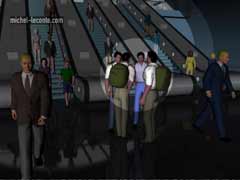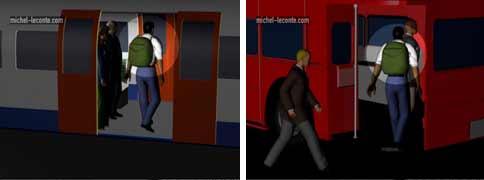LONDON BOMBINGS - 7 JULLY 2005
click on pictures to see the 640x480 pixels flash movies
CHRONOLOGY OF THE LONDON BOMBINGS
ALDGATE BLAST

KING'S CROSS BLAST

EDGWARE ROAD BLAST

TAVISTOCK SQUARE BLAST IN A BUS

LONDON TUBE DIMENSIONS

LONDON TUBE DISTANCES

LONDON BLASTS - THE 4 TERRORISTS MEETING

LONDON BLASTS - TERRORISTS AND THEIR BAGS

click on picture to see the 640x480 pixels flash movie
THESE ANIMATIONS ARE AVAILABLE ON REQUEST FOR DOWNLOAD FROM OUR FTP IN SEVERAL FORMATS FROM 320X240 TO
768x576 PIXELS FOR BROADCAST VIDEO, THE WEB, COMMERCIAL, GOVERNMENTAL, EDUCATIONAL OR PERSONNAL USE

| infos
from : http://en.wikipedia.org/wiki/2005_London_transport_explosions#Attacks_on_the_Underground London bombing 7 Jully 2005 Attacks on the Underground * 08:50 — Three bombs on the London Underground exploded within fifty seconds of each other [2]: o The first bomb exploded on an eastbound Circle Line sub-surface Underground train, number 204, travelling between Liverpool Street and Aldgate. The train had left King's Cross St. Pancras about eight minutes earlier. At the time of the explosion, the third carriage of the train was approximately 100 yards (90 m) down the tunnel from Liverpool Street. The parallel track of the Hammersmith and City Line from Liverpool Street to Aldgate East was also damaged. o The second bomb exploded on the second carriage of a westbound Circle Line sub-surface Underground train, number 216. The train had just left platform 4 at Edgware Road and was heading for Paddington. The train had left King's Cross St. Pancras about eight minutes earlier. There were several other trains nearby at the time of the explosion. An eastbound Circle Line train (arriving at platform 3 at Edgware Road from Paddington) was passing next to the train and was damaged [3], along with a wall that later collapsed. There were two other trains at Edgware Road: an unidentified train on platform 2, and an eastbound Hammersmith and City Line train that had just arrived at platform 1 [4]. o The third bomb exploded on a southbound Piccadilly Line deep-level Underground train, number 311, travelling between King's Cross St. Pancras and Russell Square. The bomb exploded about one minute after the train left King's Cross, by which time it had travelled about 500 yards (450 m). The explosion took place at the rear of the first carriage of the train, causing severe damage to the rear of that carriage, as well as the front of the second one [5]. The surrounding tunnel also sustained damage. It was originally thought that there had been six, rather than three, explosions on the Underground. The bus bombing brought the reported total to seven, however this error was corrected later that day. This was because the blasts occurred on trains that were between stations, causing the wounded to emerge from both stations, giving the impression that there was an incident at each station. Police also revised the timings of the tube blasts: initial reports had indicated that they occurred over a period of almost half an hour. This was due to initial confusion at London Underground, where the explosions were initially thought to be due to a power surge. One initial report, in the minutes after the explosions, involved a person under a train, while another concerned a derailment (both of which did actually occur, but only as a result of the explosions). A Code Amber Alert was declared at 09:19, and London Underground began to shut down the network, bringing trains into stations and suspending all services [6]. The effects of the bombs are thought to have varied due to the differing characteristics of the tunnels. 1. The Circle Line is a "cut and cover" sub-surface tunnel, about 7 m (21 ft) deep. Because the tunnel contains two parallel tracks, it is relatively wide. The two explosions on this line were probably able to vent their force into the tunnel, reducing their lethality. 2. The Piccadilly Line is a deep tunnel, up to 30 m (100 ft) underground, with narrow (3.5 m, or 11 ft) single-track tubes and just 15 cm (6 in) clearances. This narrow space reflected the blast force, concentrating its effect. Attack on a double-decker bus Emergency services surround the wreckage of a bus ripped apart as part of the coordinated terrorist attack on 7 July 2005, outside the British Medical Association building with terrorist Hasib Hussain on board Enlarge Emergency services surround the wreckage of a bus ripped apart as part of the coordinated terrorist attack on 7 July 2005, outside the British Medical Association building with terrorist Hasib Hussain on board Tavistock Square. * 09:47 — An explosion occurred in Tavistock Square on a No. 30 double-decker bus operated by Stagecoach London travelling its route from Marble Arch to Hackney Wick [7]. Earlier, the bus had passed through the Kings Cross area as it travelled from Hackney Wick to Marble Arch. At Marble Arch, the bus turned around and started the return route from Marble Arch to Hackney Wick. It left Marble Arch at 09:00 a.m. and arrived at Euston bus station at 09:35 a.m., where crowds of people had been evacuated from the tube and were boarding buses. The bus then followed a diversion from its normal route because of road closures in the Kings Cross area (due to the earlier tube bombings). People who had been evacuated from the Underground were continuing to board the bus. At the time of the explosion the bus was travelling through Tavistock Square at the point where it joins Upper Woburn Place. It is not clear when or where the bomber boarded the bus, and the police have appealed for witnesses [8]. The explosion ripped the roof off the top deck of the vehicle and destroyed the back of the bus. Witnesses reported seeing "half a bus flying through the air". The detonation took place close to the British Medical Association building on Upper Woburn Place, and a number of doctors in or near the building were able to provide immediate emergency medical assistance. BBC Radio 5 and The Sun newspaper [9] later reported that two injured bus passengers said that they saw a man exploding in the bus. News reports have identified Hasib Hussain as the person with the bomb on the bus [10]. The bus bomb exploded towards the rear of the vehicle's top deck, totally destroying that portion of it but leaving the front of the bus intact. Most of the passengers at the front of the top deck are believed to have survived, as did those on the front of the lower deck including the driver, but those at the top and lower rear of the bus took the brunt of the explosion. The extreme physical damage caused to the victims' bodies resulted in a lengthy delay in announcing the death toll from the bombing while the police determined how many bodies were present and whether the bomber was one of them. A number of passers-by were also injured by the explosion and surrounding buildings were damaged by fragments. Two more suspicious packages were found on underground trains and were destroyed using controlled explosions. Police later said they were not bombs. |

